Comprehensive Guide to Fly Killer Sprays

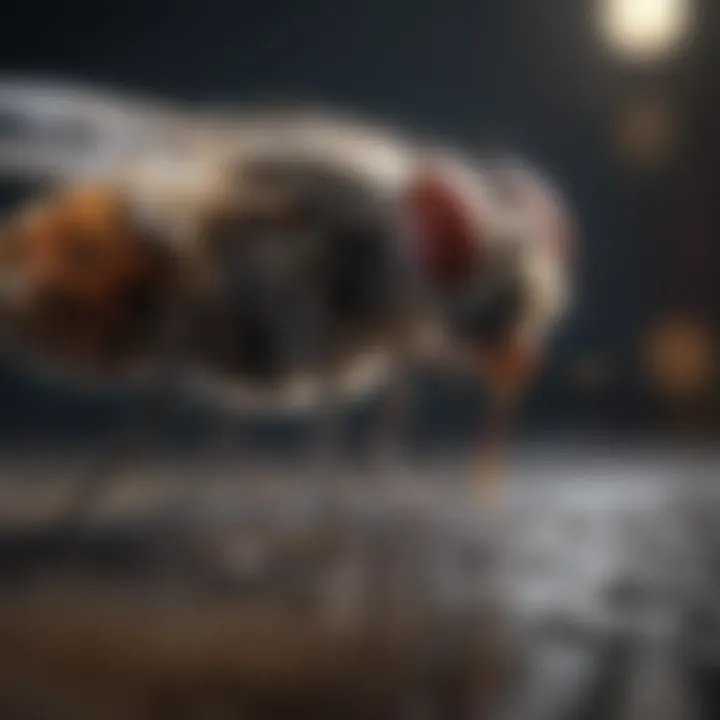
Intro
In the battle against household pests, flies are often an unwelcome presence. Their rapid reproduction and adaptability can turn a clean home into a breeding ground for annoyance and potential health risks. A significant factor in managing these pests effectively is understanding both their biology and the control methods available. This article seeks to provide a comprehensive overview of fly killer sprays, detailing their active ingredients, mechanisms of action, and the importance of ecological considerations. For homeowners and pest control professionals alike, the right information can lead to more effective pest management strategies.
Understanding the Pest
Identification
Flies belong to the order Diptera, characterized by having two wings. The most common household fly is the Musca domestica. These flies are usually grey or black and can be recognized by their buzzing sound. They are about 1/4 to 1/2 inch in length. Their presence typically indicates unhygienic conditions, as they are attracted to decaying organic matter, garbage, and pet waste.
Life Cycle
Flies have a fascinating life cycle that can progress rapidly, consisting of four stages: egg, larva, pupa, and adult. The process begins when an adult fly lays hundreds of eggs in suitable locations. After a day, these eggs hatch into larvae, commonly known as maggots. Over several days, these maggots feed and grow before entering the pupal stage. Within a week or two, the cycle culminates as adult flies emerge ready to reproduce. Understanding this cycle is crucial for effective pest management.
Pest Prevention Strategies
Environment Modification
Preventing flies from infesting your home starts with modifying the environment. This can include:
- Removing food sources: Keep food covered and dispose of garbage regularly.
- Cleaning drains: Flies are often attracted to accumulated organic matter in drains, so regular cleaning is essential.
- Proper waste management: Use tight-fitting lids on garbage bins and compost piles.
Physical Barriers
Using physical barriers such as window screens and insect nets can significantly reduce fly entry into the home. These barriers are often overlooked but can be quite effective in providing a first line of defense against these pests.
Control Methods
Chemical Control
Chemical control methods include various fly killer sprays. They typically contain active ingredients such as pyrethroids, which are synthetic chemicals modeled after natural insecticides. When using these products, it is imperative to follow the instructions provided by the manufacturer to ensure safety while maximising efficacy.
Biological Control
An alternative method for controlling flies is through biological strategies. This includes the introduction of natural predators like certain types of wasps, which can help in reducing fly populations without extensive chemical usage. Understanding the ecological balance can enhance pest control efforts effectively and sustainably.
Proper pest management not only targets the flies but also focuses on maintaining an ecologically responsible approach that can yield sustainable results.
Understanding Fly Infestations
Understanding fly infestations is crucial in the context of pest control. Flies are not just an annoyance; they can pose significant threats to health and hygiene. Knowledge of the types of flies that may invade your space can inform effective control measures. It facilitates the identification of factors that contribute to infestations and underscores the necessity for timely intervention.
Types of Flies
House flies
House flies are common household pests. They are known for their rapid reproduction and adaptability. One key characteristic is their ability to breed in a variety of environments, making them prevalent in urban areas. House flies can carry diseases due to their contact with unsanitary surfaces. Their unique feature is the high number of eggs they can produce, resulting in large populations in short periods. This makes their control vital in preventing health risks.
Fruit flies
Fruit flies are typically attracted to ripened or decaying fruits. They are small in size, which allows them to easily enter homes through open windows or doors. Their key characteristic is their exceptional sense of smell, which directs them to fermenting foods. This can result in problems, especially in kitchens. A unique feature of fruit flies is that they can reproduce in just a week, leading to rapid infestations. This aspect highlights the need for immediate attention to food storage and cleanliness.
Drain flies
Drain flies, often called moth flies, thrive in moist environments. Areas like sinks, drains, and sewage systems are ideal breeding grounds for them. Their key characteristic is a fuzzy appearance, which makes them distinguishable from other fly types. Drain flies have a unique feature of being able to fly and breed in even the dirtiest conditions. Their presence indicates potential hygiene issues that need to be addressed to eliminate breeding sites and improve sanitation.
Stable flies
Stable flies resemble house flies but are more commonly associated with livestock and stables. This fly feeds on the blood of animals, and its bite can be painful. The key characteristic of stable flies is their ability to transmit diseases among livestock, which can affect farmers economically. Their unique feature is that they can travel long distances, which enables infestations to spread rapidly in agricultural areas. Thus, controlling their population is essential for safeguarding both animals and property.
Signs of Infestation
Visible flies
Visible flies are often the first sign of an infestation. Noticing flies buzzing around indicates that something needs attention. The key characteristic that makes visible flies significant is their ability to multiply quickly. Their presence suggests that there may be food sources or breeding sites nearby. An advantage of spotting flies early is that it allows homeowners to address the problem before it escalates, helping reduce the potential health risks associated with infestations.
Breeding areas
Identifying breeding areas is essential in managing fly infestations. Flies tend to reproduce in damp and decaying matter, such as trash or waste. The key characteristic of breeding areas is that they often go unnoticed until the fly population expands significantly. Recognizing these spots provides a direct approach to reduce fly numbers. An advantage is that, through regular inspection and cleaning, homeowners can disrupt the breeding cycle, making it harder for flies to thrive.
Contaminated food sources
Contaminated food sources can attract flies and contribute to infestations. Food left exposed, especially sugary substances and organic waste, can become magnet for flies. The key characteristic of these sources is their ease of access, allowing flies to infest with little effort. This poses health risks, as flies can transfer bacteria and pathogens to food. The unique feature of recognizing contaminated items is that it offers immediate actionable steps for homeowners, promoting better food storage practices and cleanliness.

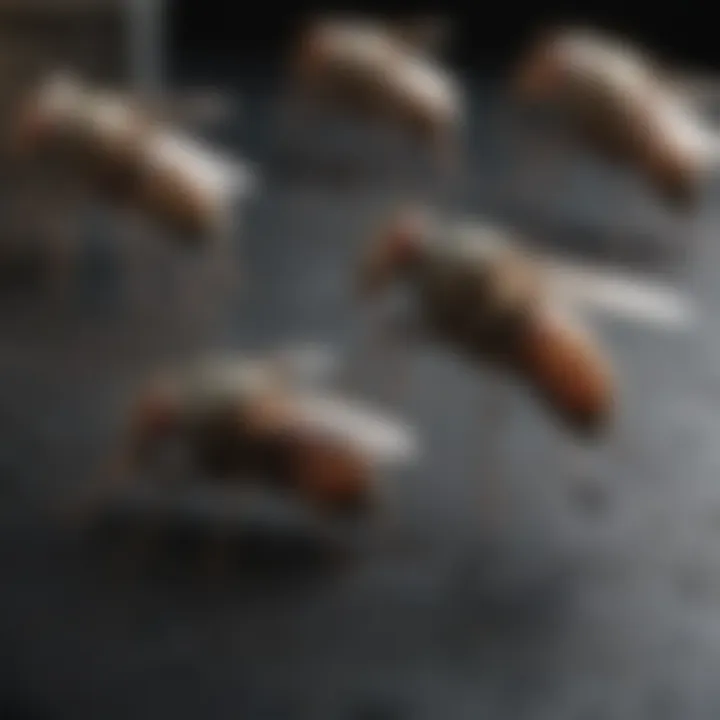
"Prevention is key in controlling fly infestations, as awareness and cleanliness can substantially reduce health risks."
Understanding the intricacies of fly infestations provides homeowners with the tools to prevent and manage issues effectively. The knowledge surrounding the types of flies and their signs of infestation lays a solid foundation for subsequent sections on control measures and effective sprays.
The Necessity of Fly Control
Understanding why fly control is necessary encompasses various factors tied to public health and economic stability. Flies are not just irritating pests; they play roles in spreading diseases and can have significant financial implications for both homes and businesses. Therefore, implementing effective fly control practices is crucial in minimizing their presence and impact.
Health Risks
Disease transmission
Flies are known vectors for numerous diseases. They can carry pathogens on their bodies, leading to the transmission of illnesses such as Salmonella, E. Coli, and various enteric infections. When flies land on food, they can contaminate it, creating direct pathways for disease. This characteristic significantly emphasizes the importance of fly control in residential settings. The potential health threats from fly-borne diseases necessitate vigilance. Moreover, the continued monitoring and management of fly-related risk could prevent outbreaks that arise from poor hygiene control.
Food contamination
Food contamination arises when flies infiltrate food preparation and storage areas. They can lay eggs in suitable food sources, producing further infestations and the potential for foodborne illnesses. This aspect makes fly avoidance especially critical for households. The presence of flies in kitchens or dining areas is not just unpleasant; it poses serious risks to food safety. Understanding this unique feature of food contamination aids in highlighting the need for effective fly control measures. Contaminated food results not only in wasted resources but can also harm health, leading to medical costs and loss of consumer trust in businesses.
Economic Impacts
Damage to property
Fly infestations can result in visible and costly damage, particularly in environments such as farms or food processing facilities. Flies can degrade the structural integrity of buildings through their activity and waste. This aspect underlines the financial burden of neglecting fly control. The repairs and cleaning required to address property damage caused by pests can be extensive. Investing in fly control upfront is more economical than the potential costs associated with property repair and maintenance.
Loss of business
The presence of flies can be detrimental to businesses, especially those in the food industry. Customers may avoid establishments plagued by fly problems, resulting in loss of revenue. Effective fly control can protect businesses from potential reputational damage. Businesses that consistently manage fly populations not only enhance customer satisfaction but can also foster long-term growth. The connection between fly control and economic stability cannot be overstated, as effective management plays a crucial role in sustaining commercial viability.
Effective fly control measures are not simply a matter of convenience; they are an essential aspect of ensuring health and economic stability.
What to Look for in a Fly Killer Spray
When selecting a fly killer spray, there are several critical factors to consider. The effectiveness of the product is paramount for achieving the desired control over the fly population. Understanding the active ingredients and their specific functions enables users to choose sprays that align with their specific needs. Additionally, considerations of safety for both users and the environment often influence product choices. A thorough comprehension of these factors can significantly impact the performance of fly control strategies, allowing for informed decision-making in a pest management approach.
Active Ingredients
Active ingredients in fly killer sprays play a vital role in determining their effectiveness and safety. Each ingredient has unique properties that contribute to how well the product performs.
Pyrethrins
Pyrethrins are natural insecticides derived from chrysanthemum flowers. They work by targeting the nervous system of insects, leading to rapid paralysis and death. This property makes pyrethrins an effective choice for controlling flies. The key characteristic of pyrethrins is their fast action, as they can quickly eliminate flies upon contact. However, they have a relatively short residual life, which means reapplication may be needed more frequently. This can be seen as a disadvantage for long-term control but may appeal to those seeking immediate results without prolonged chemical exposure.
Organophosphates
Organophosphates are synthetic chemicals that inhibit enzymes critical for insect nerve function. Their potency makes them a popular option in commercial fly control applications. The key attribute of organophosphates is their long-lasting effects, which can provide extended fly control. However, they are also associated with health risks for humans and pets, as they can be toxic if not used properly. Therefore, the advantage of effective fly elimination must be weighed against potential safety concerns, necessitating cautious handling and application.
Neonicotinoids
Neonicotinoids are a class of neuro-active insecticides. They disrupt the transmission of nerve impulses in insects, leading to effective mortality rates among flies. A distinctive feature of neonicotinoids is their systemic action, which can provide protection against insect infestations for a longer duration. They are widely regarded as beneficial due to their efficacy against various pests. However, concerns have emerged regarding their environmental impact, particularly on beneficial insects like bees. This has led some users to consider alternatives that might be less harmful to non-target species.
Target Suitability
The target suitability of a fly killer spray refers to whether it is effective for indoor or outdoor use. Understanding this aspect can greatly affect the success of fly control efforts.
Indoor vs Outdoor Use
The classification of a spray as suitable for indoor or outdoor environments can dictate its effectiveness. Indoor-specific products are often formulated to avoid unpleasant odors and residues that could be harmful in close quarters. Conversely, outdoor sprays are typically designed for a broader range of environmental conditions. The key characteristic of selecting appropriate sprays involves understanding where and how flies are entering spaces or breeding. For example, targeting outdoor applications can reduce populations near areas where families gather, such as playgrounds or patios. However, some outdoor-focused products may not be as effective in confined indoor spaces due to their intended formulation.
Surface Application
Surface application refers to how the spray must be applied to achieve maximum efficacy. Some sprays are designed for targeting surfaces where flies frequently land, while others may be intended for a more versatile approach. The primary advantage of targeted surface sprays is that they create a barrier that repels flies from specific areas. This can be particularly useful in kitchens or dining areas where food is present. However, understanding which surfaces are suitable for these applications is crucial, as some materials can react adversely with certain chemicals.
Aerosol vs Liquid Formulations
Aerosol formulations often offer ease of use and convenient application. They provide a fine mist that can cover larger areas and are effective in treating visible fly infestations. Liquid formulations, on the other hand, may allow for more directed application and can sometimes provide a longer-lasting impact. A clear distinction lies in their usability; aerosols may require less preparation, while liquid options might necessitate more careful measurement and handling. Each has its advantages and disadvantages that can affect the outcome of fly management strategies.
User Safety
User safety is a prime concern when handling fly killer sprays. There are three primary components that consumers must consider for safe application.
Personal Protective Equipment
The use of personal protective equipment, such as masks, goggles, and gloves, is vital when applying fly killer sprays. These items significantly reduce the risk of exposure to potentially harmful chemicals. The key to personal safety is understanding the chemicals present within the product and taking necessary precautions. Some formulations may require more extensive protective measures than others, but observing safety guidelines is always beneficial to protect against adverse effects.
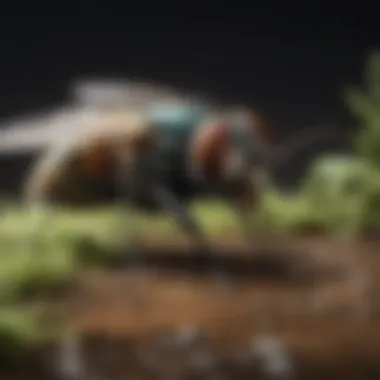
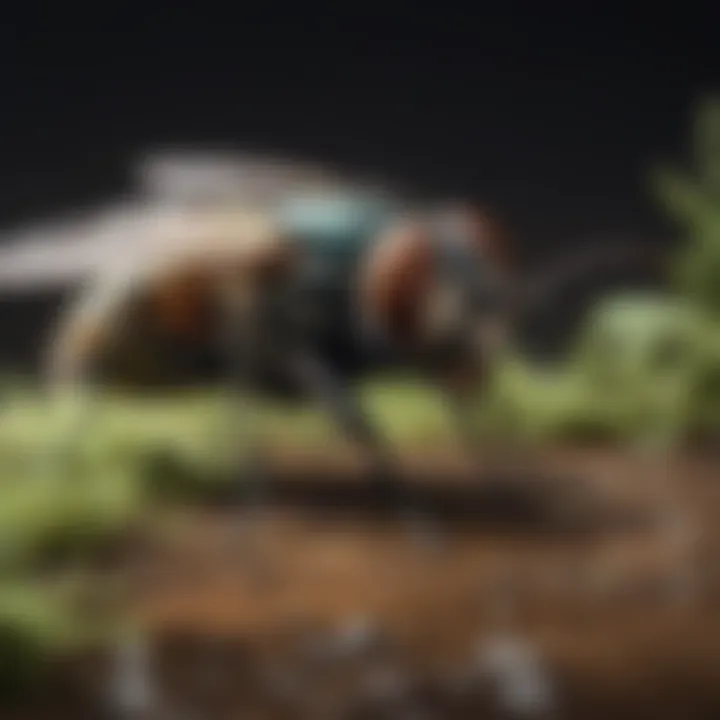
Application Instructions
Following application instructions is essential for achieving optimal results. Proper adherence to guidelines ensures that the spray is used effectively and safely. Different products will have varying requirements regarding preparation and use. Improper application can not only hinder efficacy but also pose risks to human health. Therefore, consumers must take the time to read and understand the directions provided, thereby empowering themselves to use these products safely.
Child and Pet Safety
Safety for children and pets is a critical factor in the selection of fly killer sprays. Many household pesticides can pose health risks if not used with care. Sprays designed with child and pet safety in mind often feature formulations that minimize toxicity. These products may also include detailed instructions on how long to wait before allowing access to treated areas.
"Using fly killer sprays responsibly not only protects your home but also ensures the safety of your loved ones."
Analysis of Top Fly Killer Sprays
The examination of top fly killer sprays is crucial in this article. It allows the reader to make informed decisions based on the efficacy, safety, and environmental impact of various products. Fly killer sprays are essential tools in managing fly populations effectively in both domestic and commercial settings. Understanding the nuances between different brands can significantly influence the success of fly control measures. Hence, thorough analysis provides clarity on advantages and potential drawbacks, ensuring that decisions made by homeowners prioritize both effectiveness and safety.
Product Reviews
Review of Brand A
Brand A is recognized for its robust formula that effectively eliminates flies upon contact. The active ingredients present in this spray focus on immediate knockdown of adult flies, making it popular among users who need quick results. One key characteristic of Brand A is its fast-acting nature. This allows for immediate relief in environments that require rapid fly control, such as kitchens and dining areas. However, its effectiveness comes with a downside; it tends to have less residual effect, meaning it may not deter flies from returning shortly after application. In the context of this article, Brand A stands out for those seeking immediate solutions but may require frequent reapplication to maintain long-term control.
Review of Brand B
Brand B offers a balance between immediate efficacy and prolonged protection. This product is designed with a unique blend of active ingredients that not only kill flies quickly but also provide a residual barrier against future infestations. The residual effect is particularly useful for maintaining fly-free spaces over extended periods. Users often appreciate this dual-functionality as it reduces the frequency of applications. However, some may find that its strength can lead to a cautious approach regarding safety around pets and children. Therefore, for those looking for both immediate results and longer-lasting protection, Brand B is a solid choice, embodying a more strategic approach to fly management.
Review of Brand
Brand C distinguishes itself by focusing on eco-friendly practices while still delivering effective fly control. This spray features natural active ingredients which make it less harmful to beneficial insects and non-target wildlife. Many users favor Brand C for its commitment to reduced environmental impact, allowing for applications in areas frequented by children and pets with reduced safety concerns. However, the unique feature of this brand comes with a trade-off. It may require more frequent application compared to its synthetic counterparts. Consequently, while Brand C is excellent for environmentally conscious consumers, it may not be ideal for those seeking rapid and wide-scale fly elimination.
Efficacy Comparisons
Immediate Kill vs Residual Effect
Understanding the difference between immediate kill and residual effect is essential for choosing the right fly spray. Products that provide immediate kill focus on eliminating flies upon contact. This approach is beneficial in situations where instant relief is necessary, such as during events or gatherings. However, these sprays may lack the longevity of effect, requiring tiresome reapplications. On the other hand, sprays that emphasize residual effects create a protective barrier that continues to repel and kill flies after application. Such products are beneficial for maintaining control over time, particularly in high-infestation areas. The ideal choice will depend on individual needs; emergency situations may favor products with immediate effects, while long-term strategies should rely on those with residual capabilities.
Targeted Fly Activity
Evaluating targeted fly activity is another important aspect to consider. Some sprays are formulated to attract and target specific types of flies, such as fruit flies or house flies. This specificity can enhance the efficacy of the product, as it reduces competition among different flies for the bait or traps used in conjunction with sprays. However, broad-spectrum sprays can impact a wider range of pests, though they may not be as effective against particular species. Consumers must weigh their unique circumstances—targeted activity can offer precision, while comprehensive coverage addresses multiple pest issues at once.
Environmental Considerations
Environmental considerations are crucial when selecting fly killer sprays, especially in today’s context of heightened ecological awareness. The choices made in pest control can significantly affect various ecosystems. It is not just about eradicating flies but also ensuring that beneficial insects, birds, and mammals are not harmed in the process. A deeper understanding of these elements helps in making informed decisions that balance efficacy with environmental responsibility.
Impact on Non-Target Species
Beneficial insects
Beneficial insects play an important role in maintaining a balanced ecosystem. They contribute to pollination, decomposing organic material, and controlling pest populations. Examples include bees, ladybugs, and parasitic wasps. These insects are often targeted unintentionally by broad-spectrum insecticides. This can lead to significant ecological imbalance, affecting plant production and overall biodiversity.
Using fly killer sprays that have lower toxicity to non-target species can preserve beneficial insects. Selecting products that specifically target flies without harmful impacts on these insects is essential.
Some beneficial insects can adapt quickly, leading to natural pest control. Choosing selective insecticides helps maintain their populations, promoting a healthier environment. The unique feature of these targeted sprays is in their formulation that minimizes exposure to beneficial insects, thus sustaining their populations while controlling flies.
Birds and mammals
Birds and mammals also serve critical functions in the ecosystem. They act as natural predators of various pests, including flies. The decline in these populations due to pesticide use can lead to increased fly numbers, defeating the purpose of the sprays. Moreover, some insecticides can accumulate in the food chain, harming birds and mammals that consume insects.
To protect these non-target species, it is crucial to understand the active ingredients in fly killer sprays. Certain products are designed to be less harmful to birds and mammals, which makes them safer choices for residential use. However, it is important to apply these sprays judiciously, considering their potential impact on nearby wildlife. The unique advantage of using eco-friendly options is their ability to control flies while safeguarding the health of the surrounding environment.
Eco-Friendly Alternatives
Natural repellents
Natural repellents are an excellent choice for those looking to avoid synthetic chemicals in pest control. These repellents often use plant-derived ingredients, making them inherently less toxic. Examples include citronella, peppermint oil, and eucalyptus oil. These natural options are gaining popularity among homeowners who are sensitive to conventional insecticides.
The key characteristic of natural repellents is their ability to create an unfavorable environment for flies without the harsh chemicals found in many commercial sprays. While effective, they usually have a shorter duration of action compared to synthetic products. Thus, they may require more frequent application. Understanding these limitations is essential when considering their use in proactive fly management.
Traps and baits
Traps and baits offer a targeted approach to fly management. They draw flies to a specific location, reducing their numbers without widespread chemical exposure. Various types of traps are available, from sticky traps to bait stations that attract and kill flies.
One of the main advantages of using traps is that they pose little threat to non-target species, making them suitable for both indoor and outdoor settings. Their integration into an overall pest management strategy can significantly reduce fly populations while maintaining ecological integrity. The unique feature of traps is that they allow for monitoring pest activity, informing future pest management decisions.
Best Practices for Application
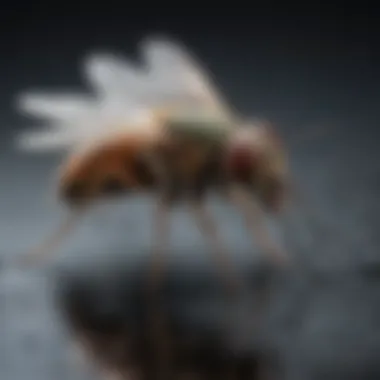
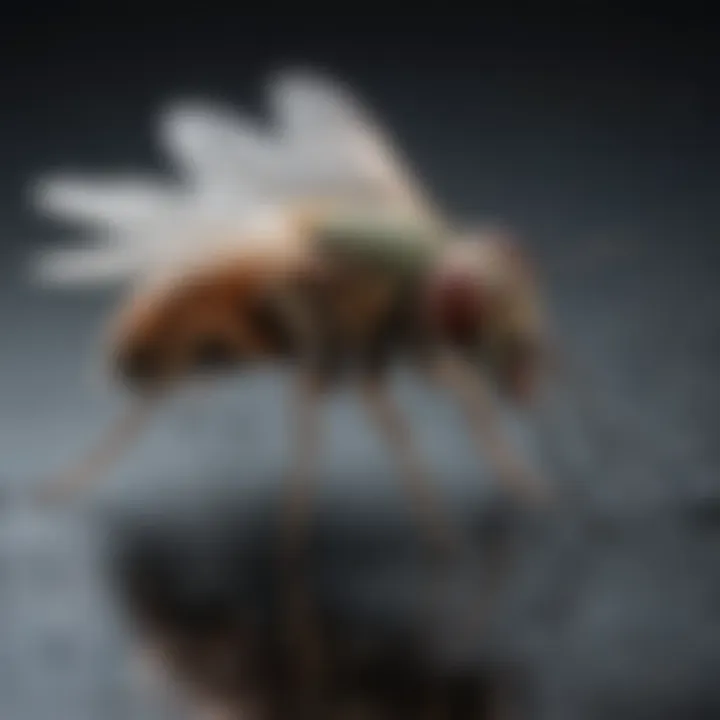
Effective application of fly killer sprays is crucial for achieving desired results in pest control. When done correctly, it not only enhances the efficacy of the sprays but also ensures safety for individuals and pets in the vicinity. Understanding best practices helps in strategic approaches against infestations, maximizing outcomes while minimizing risks.
Timing and Frequency
Seasonal considerations
Timing is a significant factor when applying fly killer sprays. Seasonal considerations influence not only the type of flies prevalent at different times but also their breeding habits. During warmer months, flies tend to increase in number, as the environmental conditions favor their reproduction. Therefore, applying sprays in early spring can effectively manage populations before they reach peak numbers.
Additionally, understanding seasonal behaviors can assist in planning. For instance, many homeowners may find that flies are less problematic in the winter; however, indoor infestations may occur due to warmth and food sources. Consequently, tailoring application times to align with these behaviors can yield better results for ongoing management efforts.
Unique aspects of seasonal application include the ability to anticipate increased fly threats and reduce the likelihood of over-reliance on chemical treatments, promoting healthier living spaces.
Monitoring fly activity
Monitoring fly activity serves as a critical component in pest control strategies. By observing areas where flies are most active, homeowners can focus treatments on hotspots to increase the effectiveness of sprays. Frequent check-ins provide insight into the persistence or reduction of fly populations after application.
This tactic not only optimizes resource allocation but also helps in identifying breeding grounds, which, if left unresolved, can lead to future outbreaks. The unique advantage of this method lies in its preventive capability; by being informed about fly activity, users can decide when and where to reapply sprays, ensuring a timely response to any resurgence.
Technique and Coverage
Even application
Achieving an even application of fly killer sprays is critical. This technique ensures comprehensive coverage across the targeted area, preventing any spots where flies may avoid contact with the solution. Uneven application can lead to untreated areas, allowing flies to persist, thus undermining the entire effort in pest control.
The key characteristic here is thoroughness. When sprays are distributed evenly, it increases the likelihood of contact with flies, enhancing the overall effectiveness. In practice, using tools that support fine misting can help in achieving this. While the method requires careful attention, its advantage includes long-lasting effects, reducing the need for frequent reapplication.
Focal areas of infestations
Identifying and focusing on focal areas of infestations can significantly influence the outcome of fly control efforts. Flies congregate in specific locations based on available food and breeding grounds. Targeting these areas with concentrated applications optimizes both the impact and efficiency of the sprays.
Key benefits include reduced waste of products and speedier results in eliminating adult flies and disrupting breeding cycles. The unique challenge, however, is correctly recognizing these hotspots, which may require diligent observation and awareness. A targeted approach can pay off significantly in reducing overall fly populations and ensuring a healthier environment.
Post-Application Procedures
Post-application procedures are a crucial part of managing fly infestations effectively. After applying fly killer sprays, homeowners need to perform certain tasks to enhance safety and effectiveness. These procedures ensure that the area remains free from pests while minimizing health risks to residents and pets. Also, they play a significant role in preventing future infestations.
Cleaning and Safety
Disposal of insect remains
Disposing of insect remains is critical in maintaining a hygienic environment after using fly killer sprays. Dead flies can be a breeding ground for bacteria, which can lead to other health risks. By properly disposing of these remains, you can ensure a cleaner living space. You should vacuum or sweep up the carcasses promptly. A vacuum with a sealed chamber is beneficial as it prevents the spread of potential pathogens.
Additionally, using a double-bagging method for disposal is a good choice. This reduces the risk of any insects escaping back into the environment. Neglecting to remove dead flies can also attract more pests, counteracting efforts taken in spraying. In this respect, thorough disposal not only contributes to cleanliness but also aids in the overall goal of effective pest control.
Sanitizing areas
Sanitizing areas where flies were present is equally important as removing deceased insects. This step helps eliminate lingering odors and any bacteria that could pose health risks. Using a suitable disinfectant is an effective way to ensure that surfaces are free from contaminants. Each disinfectant may have its unique properties, but a key characteristic is its ability to kill germs and bacteria.
In this article, using eco-friendly disinfectants, such as vinegar or alcohol-based solutions, is recommended. They are safer for homes with pets and small children. Simply wiping down the surfaces or spraying the disinfectant and allowing it to sit for a period are common techniques. By sanitizing areas, you not only promote hygiene but also minimize the chances of future insect attraction.
Ongoing Monitoring
Assessing effectiveness
Assessing the effectiveness of the fly killer spray involves checking the outcome of the application. This includes looking for any active flies post-application and determining whether the product worked as intended. A physical inspection may reveal the presence of flies, while a lack of them can indicate success. Monitoring these results is essential because it guides further action.
Moreover, regular assessments can help inform you if additional applications are necessary. The unique aspect of ongoing assessment is that it aids in refining your fly management strategy. If a product is found ineffective, switching to alternatives can prevent wasting resources and time in the long run.
Preventing future infestations
Preventing future infestations requires a proactive approach after cleaning and monitoring. Regularly practicing good sanitation methods, such as keeping food covered and cleaning up spills, is beneficial. Noticing any changes in fly activity can also help manage potential outbreaks before they escalate.
A key characteristic of this preventative method lies in its simplicity. By maintaining vigilance, you can create an environment where flies have less opportunity to thrive. The ongoing monitoring also fosters awareness, enabling homeowners to address issues promptly. Thus, integrating these practices into daily routines can significantly reduce the likelihood of flies returning.
Finale
The topic of fly killer sprays is crucial for both residential and commercial pest management. Effective fly control not only protects one’s home from bothersome pests, but it also plays an important role in health and sanitation. A well-chosen product can eliminate flies swiftly, thus reducing the risks associated with their presence.
Summarizing Effectiveness of Fly Killer Sprays
Fly killer sprays vary significantly in their effectiveness. Products containing active ingredients such as pyrethrins generally provide immediate knockdown of flies, while those with longer-lasting formulations offer residual protection. It is essential to select a spray that meets specific needs, whether for indoor or outdoor application. The effectiveness of these sprays is often tied to their formulation and how well they are applied.
"Understanding the specific needs of a fly problem can lead to better choices in spray selection."
In addition, consumer feedback and product reviews can offer insights into how well a spray performs in real-world conditions. The most effective sprays not only kill flies but also minimize potential harm to humans and pets, making user safety an essential consideration.
Future Directions in Fly Management
The future of fly management may pivot towards more sustainable methods. As awareness of environmental impact grows, there is a shift towards eco-friendly formulations and natural repellents. Research is ongoing in developing biopesticides derived from natural sources that target flies specifically while being safe for non-target species.
Advancements in trapping technology, such as pheromone traps, offer additional avenues for reducing fly populations without the use of chemicals. Integrating these alternatives into pest management strategies could revolutionize how homeowners manage fly infestations.







